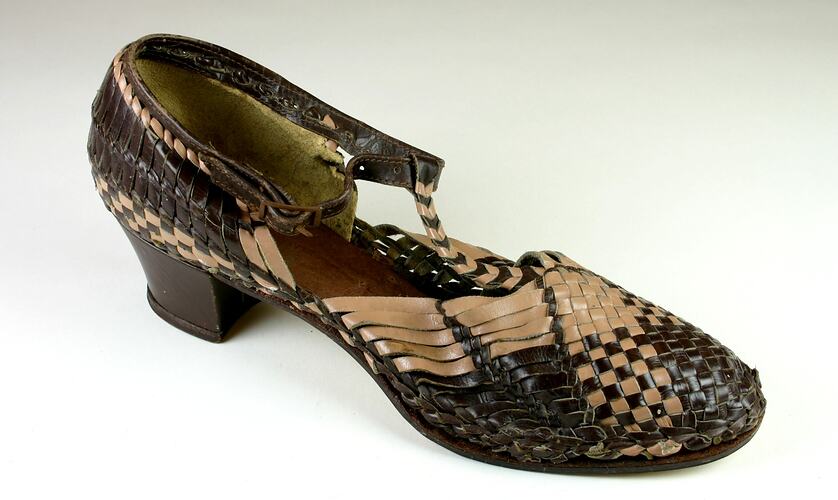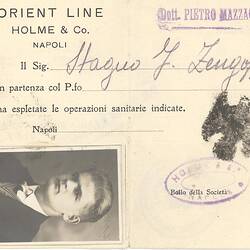Summary
Pink and brown leather basketweave women's shoe was one of Stanio Fancoff's shoe samples. It would have been shown to prospective purchasers as an example of Stanio's stock of shoes which were made at his shoemaking business in Fitzroy by himself and his family.
Stanio Ivanoff Fancoff was born in 1908 in Bojentsi, a small village in Bulgaria. At age 11, Stanio left home to learn the shoemaking trade. In 1929, he immigrated to Melbourne, settled in Fitzroy and began to work for the V.G. Zemancheff & Sons basket shoe factory in South Melbourne. In 1936, he married Dorotea Georgi Touzou who had recently arrived in Australia. Around this time, Stanio set up his own shoemaking business from home, with Georgi, her cousin and sister weaving the shoes which he then assembled. Selected shoe samples were then taken to Sydney and Tasmania for sale. In 1942, Georgi and Stanio moved to Broken Hill for Georgi's health; daughter Nancy was born there and Stanio set up a shoe shop/factory. In 1945, Georgi died and by 1950 Stanio and Nancy had moved to Adelaide where he again opened a shoemaking business and shop. He passed away in 1978, having been in the shoemaking business for 59 years.
Physical Description
Right foot low heeled female dress shoe of pink and brown leather basketweave. Enclosed shoe, slightly rounded shape toe with 'T' strap and ornate metal buckle on right side. Lower back shoe section appears in a woven checkered pattern, top portion appears as two rows of vertical stripes, topline including cross strap is in unwoven brown leather. Toe cap and vamp are woven within a diamond shaped pattern, while a patterned thin strap joins throat to central cross strap. Complete with neutral coloured quartier but no insole lining. Neutral coloured leather sole inscribed and stamped on base, with heel of 4cm height and depth, one tack inserted mid-way up the sole, while three tacks connect heel to sole. Leather wraps around heel, joining at heel breast centre.
Significance
This collection is significant in documenting a small migrant business as well as the fashion of a particular period. It is well provenanced and charts the application of trade skills in a new country. It also illustrates the stages of hand shoe manufacture from the 1930s, demonstrating the enduring nature of the tools and patterns that were used.
More Information
-
Collecting Areas
Migration & Cultural Diversity, Working Life & Trades, Leisure, Clothing & Textiles
-
Acquisition Information
Donation from Nancy Vasileff, 21 Mar 2007
-
Maker
-
Inscriptions
Inscribed sole base: '4' Stamped sole base: Stamp is slightly worn away, appears oval in shape with a central ring with inscription 'S. FANCOFF.', while outer ring upper 'HAND MADE' and the lower portion reads blurrily '..T SHOES ' Sole base arch: Pencil written at top of sole arch: 'G12 / NETT'
-
Classification
-
Category
-
Discipline
-
Type of item
-
Overall Dimensions
260 mm (Length), 80 mm (Width), 105 mm (Height)
-
References
R.A. Salaman, 'Dictionary of Leather-working Tools c.1700-1950 and Tools of Allied Trades,' London: George Allen and Unwin (Publishers) Ltd, 1986 [Section 2: Boot and Shoe Maker pp18-185]. John Peacock. 'Shoes, The Complete Sourcebook,' London:Thames & Hudson Ltd, 2005. NAA holds file (online) on Vasil George Zemancheff, Fancoff's employer
-
Keywords
Boot & Shoemaking, Bulgarian Communities, Bulgarian Immigration, Immigration, Small Businesses, Women's Footwear

